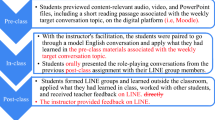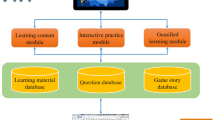Abstract
Although the flipped class has been hotly discussed, the clicker-aided flipped EFL class (CFEC) still remains a mystery for most scholars. This study aims to determine the correlations between the initial EFL proficiency and other variables of the clicker-aided EFL flipped class. The sample was made up of randomly selected 79 participants (Female =38; male =41), who received the clicker-aided EFL flipped class for one academic semester. It is found that there is a significantly positive relationship between the initial and the final EFL proficiency, motivation levels and cultural awareness in CFEC, whereas there is a negative relationship between initial EFL proficiency and cognitive loads in CFEC. The initial EFL proficiency is therefore an essential factor to influence the effectiveness of the flipped class. Future studies may consider this when exploring the educational technology aided flipped class.

Similar content being viewed by others
Explore related subjects
Discover the latest articles, news and stories from top researchers in related subjects.References
Beatty, I. (2013). Transforming student learning with classroom communication systems. Educause Research Bulletin, 3, 1–13.
Bekele, T. A. (2010). Motivation and Satisfaction in Internet-Supported Learning Environments: A Review. Educational Technology & Society, 13(2), 116–127.
Brady, N. C., Thiemann-Bourque, K. T., Fleming, K., & Matthews, K. (2013). Predicting language outcomes for children learning augmentative and alternative communication: child and environmental factors. Journal of speech, language, and hearing research, 56, 1595–1612.
Bryman, A. (2004). Social research methods (2nd ed.). Oxford: Oxford University Press.
Clayton, K., Blumberg, F., & Auld, D. P. (2010). The relationship between motivation, learning strategies and choice of environment whether traditional or including an online component. British Journal of Educational Technology, 41(41), 349–364.
Constantine, M., & Ladany, N. (2000). Self-report multicultural counseling competency scales: Their relation to social desirability attitudes and multicultural case conceptualization ability. Journal of Counseling Psychology, 47, 155–164.
Creswell, J. W. (2003). Research design: Qualitative, quantitative, and mixed methods approaches. Thousand Oaks: Sage.
Davis, R. S., Dean, D. L., & Ball, N. (2013). Flipping the classroom and instructional technology integration in a college-level information systems spreadsheet course. Educational Technology Research and Development, 61(4), 563–580.
Dörnyei, Z. (2005). The psychology of the language learner: Individual differences in second language acquisition. Mahwah: Lawrence Erlbaum Associates.
Duncan, D. (2005). Clickers in the classroom: How to enhance science teaching using classroom response systems. San Francisco: Pearson Education/Addison-Wesley/Benjamin Cummings..
Espinoza, L. M. (2010). Assessment of young English language learners. In E. E. Garcia & E. C. Frede (Eds.), Young English language learners: Current research and emerging directions for practice and policy (pp. 119–142). New York, NY: Teachers College Press.
Galusha, J. J. (1997). Barriers to learning in distance education. Interpersonal Computing and Technology, 5(3), 6–14.
Garcia, E. E., & Nänez, J. E. (2011). Bilingualism and cognition: Informing research, pedagogy, and policy. Washington, DC: American Psychological Association.
Ghapanchi, Z., Khajavy, G. H., & Asadpour, S. F. (2011). L2 Motivation and Personality as Predictors of the Second Language Proficiency: Role of the Big Five Traits and L2 Motivational Self System. Canadian Social Science, 7(6), 148–155. doi:10.3968/j.css.1923669720110706.030.
Han, J. H. (2014). Closing the Missing Links and Opening the Relationships among the Factors: A Literature Review on the Use of Clicker Technology Using the 3P Model. Educational Technology & Society, 17(4), 150–168.
Han, J. H., & Finkelstein, A. (2013). Understanding the effects of professors’ pedagogical development with clicker assessment and feedback technologies and the impact on students’ engagement and learning in higher education. Computers & Education, 65, 64–76. doi:10.1016/j.compedu.2013.02.002.
Hart, S. G., & Staveland, L. E. (1988). Development of NASATLX task load index Results of empirical and theoretical research. In P. A. Hancock & N. M. Kati (Eds.), Human mental workload (pp. 139–178). Amsterdam: Elsevier Science.
Huang, T. C., Huang, Y. M., & Yu, F. Y. (2011). Cooperative weblog learning in higher education: its facilitating effects on social interaction, time lag, and cognitive load. Educational Technology & Society, 14(1), 95–106.
Hwang, G. J., Chu, H. C., Liang, Y. R., & Effects of Computerized Collaborative Concept Map Approach on Students’ Learning Achievements and Cognitive Loads, ICALT, (2012). Advanced learning technologies. IEEE International Conference on, Advanced Learning Technologies, IEEE International Conference on, 2012, 258–262. doi:10.1109/ICALT.2012.233.
Jim, M. (2001). How to keep e-learners from E-Scaping. Performance Improvement, 40(40), 30–37.
Khalil, M. K., Mansour, M. M., & Wilhite, D. R. (2010). Evaluation of cognitive loads imposed by traditional paper–based and innovative computer–based instructional strategies. Journal of veterinary medical education, 37(4), 353–357. doi:10.3138/jvme.37.4.353.
Kieffer, M. J. (2008). Catching up or falling behind? Initial english proficiency, concentrated poverty, and the reading growth of language minority learners in the united states. Journal of Educational Psychology, 100(4), 851–868.
Kock, N. (2013). Using WarpPLS in e-collaboration studies: what if I have only one group and one condition? International journal of e-collaboration, 9(3), 1–12.
Li, Z. Q., & Gao, H. (2015). Socio-linguistic thoughts on the new translation items in CET 4 and CET 6. Journal of Hubei University of Economics (Humanities and Social Sciences), 4, 161–162.
Mayer, R. E. (Ed.) (2015). The Cambridge handbook of multimedia learning. New York, NY: Cambridge University press.
Nisbett, R. E., Aronson, J., Blair, C., Dickens, W., Flynn, J., Halpern, D. F., et al. (2012). Intelligence: New findings and theoretical developments. American Psychologist, 67(2), 130–159.
Panos, A., Ljubica, D., Julie, B., & Emanuel, B. (2015). Learning to think in a second language: effects of proficiency and length of exposure in english learners of german. Modern Language Journal, 99(1), 138–153.
Pintrich, P. R., & Schunk, D. H. (2002). Motivation in education: Theory, research, and application (2nd ed.). Upper Saddle River: Prentice Hall.
Pintrich, P. R., Smith, D., Garcia, T., & McKeachie, W. J. (1991). A manual for the use of the motivated strategies for learning questionnaire. Ann Arbor, Michigan: National Center for Research to Improve Postsecondary Teaching and Learning, University of Michigan.
Robert, G. G., Mary, K. S., Karen, B., Katrina, C., Rebecca, C., Garrett, J., Gwen, K., Stephanie, L., Monica, L., Kristina, V., & Kerri, W. (2005). The multicultural counseling inventory: a measure for evaluating social work student and practitioner self-perceptions of their multicultural competencies. Journal of Social Work Education, 41(2), 191–208.
Schunk, D., & Pajares, F. (2002). The development of academic self-efficacy. In A. Wigfield & J. Eccles (Eds.), Development of achievement motivation (pp. 15–31). San Diego: Academic Press.
Slomanson, W. R. (2014). Blended Learning: A Flipped Classroom Experiment. Journal of Legal Education, 64(1), 93.
Sotelo-dynega, M., Ortiz, S. O., Flanagan, D. P., & Chaplin, F. W. (2013). English language proficiency and test performance: an evaluation of bilingual students with the woodcock-Johnson III tests of cognitive abilities. Psychology in the Schools, 50(8), 781–797. doi:10.1002/pits.21706.
Tallent-Runnels, M. K., Thomas, J. A., Lan, W. Y., Cooper, S., Ahern, T., Shaw, S. M., et al. (2006). Teaching courses online: a review of the research. Review of Educational Research, 76(1), 93–135.
Tashakkori, A., & Teddlie, C. (2003). Handbook of Mixed Methods in Social and Behavioral Research. Thousand Oaks, CA: Sage.
Tong, F., Lara-Alecio, R., Irby, B., Mathes, P., & Kwok, O. (2008). Accelerating early academic oral english development in transitional bilingual and structured english immersion programs. American Educational Research Journal, 45(4), 1011–1044.
Warr, P., & Downing, J. (2000). Learning strategies, learning anxiety and knowledge acquisition. British Journal of Psychology, 91(3), 311–333.
Wiebe, E. N., Roberts, E., & Behrend, T. S. (2010). An examination of two mental workload measurement approaches to understanding multimedia learning. Computers in Human Behavior, 26, 474–481.
Wikipedia (2016). Flipped classroom. https://en.wikipedia.org/wiki/Flipped_classroom, retrieved on April, 18, 2016.
Wolters, C. A. (1999). The relation between high school students’ motivational regulation and their use of learning strategies, effort, and classroom performance. Learning and Individual Differences, 11(3), 281–301.
Worthington, R. L., Mobley, M., Franks, R. P., & Tan, J. A. (2000). Multicultural counseling competencies: Verbal content, counselor attributions and social desirability. Journal of Counseling Psychology, 47, 460–468.
Yu, J. (2011). Correlation between productive knowledge of English idioms and English proficiency. Journal of Anhui Normal University (Humanities & Social sciences, 39(3), 369–372.
Yu, Z. (2014). The influence of clickers use on metacognition and learning outcomes in college English classroom. International Journal of Information and Communication Technology Education, 10(2), 50–61.
Yu, Z. (2015a). Blended learning over two decades. International Journal of Information and Communication Technology Education, 11(3), 1–19.
Yu, Z. (2015b). Indicators of satisfaction in clickers-aided EFL class. Frontiers in Psychology, 6, 587. doi:10.3389/fpsyg.2015.00587.
Yu, Z., Chen, W., Kong, Y., Sun, X. L., & Zheng, J. (2014). The impact of clickers instruction on cognitive loads and listening and speaking skills in college English class. PloS One, 9(9), e106626. doi:10.1371/journal.pone.0106626.
Zimmerman, B. J., & Martinez-Pons, M. (1990). Student differences in self-regulated learning: relating grade, sex and giftedness to self-efficacy and strategy-use. Journal of Educational Psychology, 82(1), 51–59.
Acknowledgements
The authors wish to thank the people who help this study and the projects which financially support this study: Findings of 2014 Research Project of Philosophy and Social Sciences of Zhejiang Province “Use of Clickers in College English Class in Zhejiang Province” (14NDJC245YB), Special Fundamental Research Funds for the Central Universities (Project No.: 2013B33914/2014B10514),and 2014 Excellent Higher Education Course (Undergraduate) “Business English Writing” in Shaoxing City.
Author information
Authors and Affiliations
Corresponding author
Appendix
Appendix
A scale of cultural awareness (adapted from Robert et al. 2005) (followed by a four-point Likert scale 4 = very accurate, 3 = somewhat accurate, 2 = somewhat inaccurate, 1 = very inaccurate)
1 Cultural mistakes can quickly be recognized and recovered.
2 I understand specific racial and ethnic minority groups.
3 I have extensive professional or collegial interactions with minority individuals.
4 I think that interactions with people of different cultures are enjoyable.
5 I am involved in advocacy against institutional barriers for minority services.
6 I am familiar with nonstandard English.
7 I have extensive life experiences with minority individuals.
8 I understand the effect of age and gender roles.
9 I have “world-minded” or pluralistic outlook.
10 I often self-examine cultural biases.
11 I am aware of differences in behaviors and values of minorities considered.
12 I am aware that defensiveness is self-monitored and corrected.
13 I am aware that cognitive differences make communication difficult.
Rights and permissions
About this article
Cite this article
Yu, Z., Yu, L. Correlations between learners’ initial EFL proficiency and variables of clicker-aided flipped EFL class. Educ Inf Technol 22, 1587–1603 (2017). https://doi.org/10.1007/s10639-016-9510-0
Published:
Issue Date:
DOI: https://doi.org/10.1007/s10639-016-9510-0




